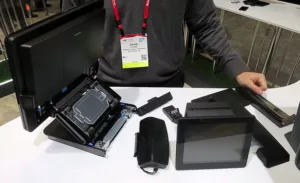Toshiba’s New TCx 800 POS Terminal, partially disassembled and with some accessories. (Credit: M. Brennesholtz)
Toshiba introduced its new TCx 800 all-in-one modular point-of-sale (POS) solution at NRF. This unit will be available later this year. In addition to the basic unit, a wide variety of accessories, both from Toshiba and others, will work with the unit. These peripherals include a customer display, printers, credit-card terminals, scales, barcode readers, etc. David Steiner, the Toshiba rep that explained the system to me, said this led to a problem that is surprisingly important to retailers considering the purchase of POS terminals: cable management. He showed how the TCx 800 was designed to cope with up to 13 different cables and still allow both normal operation and basic maintenance without damaging or pulling any of the cables loose.
The TCx 800 system is available with three different main displays for the store cashier. A 15”, 4:3, 1024 x 768 display; a 15.6” 16:9 display with 1366 x 768 resolution; and a 18.5” 16:9 display also with 1366 x 768 resolution. All three of these main displays have 10-point multitouch systems. In addition, Toshiba offers two different optional customer displays, 8” and 10”. These customer displays are non-touch.
The computer portion of the system is also very flexible and supports a variety of operating systems including TCx Sky, 4690, Linux, Windows 10 and Windows 10 IoT Enterprise 2016 LTSB 64 bit. The TCx Sky operating system was also launched at NRF. According to Toshiba, TCx Sky is a “retail-optimized operating system which offers rock-solid reliability, security and performance – enhanced with secure remote support by Netop Remote Control and a statement of direction to enable McAfee whitelisting.”
The company also unveiled the next-generation Toshiba Self Checkout solution, said to combine sleek modern design with complete modularity. I was running out of time and did not see this unit.
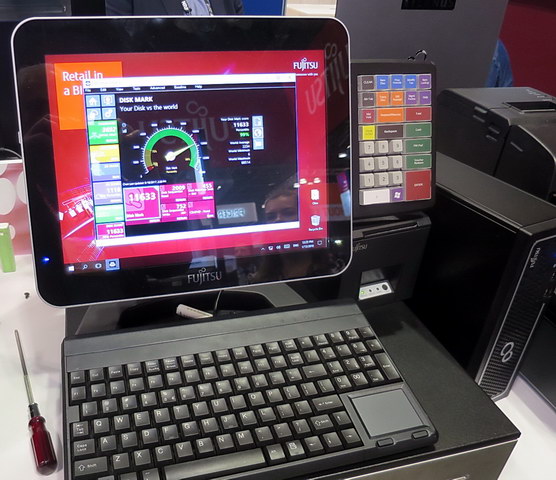 Fujitsu’s new TP8 modular all-in-one POS system with a 15” display and a variety of accessories including a keyboard, cash drawer, printer and auxiliary touch-screen keyboard. A modular box version of the TP8 computer is partially visible on the right. (Credit: M. Brennesholtz)
Fujitsu’s new TP8 modular all-in-one POS system with a 15” display and a variety of accessories including a keyboard, cash drawer, printer and auxiliary touch-screen keyboard. A modular box version of the TP8 computer is partially visible on the right. (Credit: M. Brennesholtz)
Fujitsu was showing its modular all-in-one (AIO) POS system the TP8 at NRF, which was its official debut. This updated system had been announced on January 8th, just before the show. Two displays are available for the system, 15” 4:3 and 18.5” 16:9 LCD displays. The Fujitsu rep said the 15” display has 1024 x 768 resolution, although resolution is not mentioned in any of the product descriptions. Presumably, the 16:9 version has 1366 x 768 resolution but the rep didn’t know for sure. Both displays have projected capacitive multi-touch gesturing. The monitors are field-swappable for maximum flexibility in the retail environment. There are also optional customer-facing displays for the system.
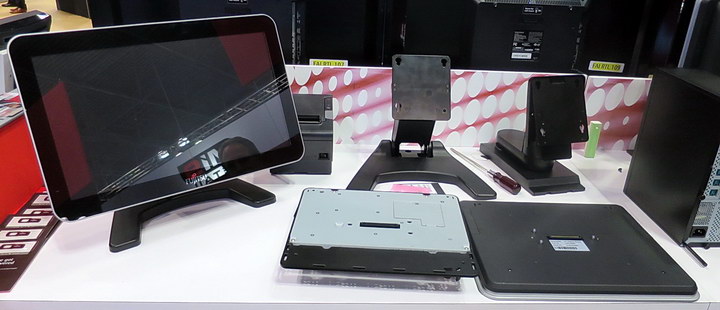 The TP8 POS system with a 18.5” display (left). The 15” display (right, face down) is shown separated from its computer (center). Two TP8 stands and an accessory printer are shown in the background. (Credit: M. Brennesholtz)
The TP8 POS system with a 18.5” display (left). The 15” display (right, face down) is shown separated from its computer (center). Two TP8 stands and an accessory printer are shown in the background. (Credit: M. Brennesholtz)
The computer portion of the AIO comes in two versions. TP8 Model A6xx or M6xx provides Intel 6th Generation “Skylake” CPUs, from Celeron A610 and M610 to Intel Core i5 A650 and M650. These models of the unit are primarily designed to run Windows 7 or Windows 8+, although they can all be updated to Windows 10. This model is targeted at retailers that run legacy Windows 7 or 8 store management software. In particular, it is for those who wish to extend the service life of POSReady 7 software past 2020. The M6xx versions are said to be particularly easy to upgrade to Windows 10 and would be preferred by retailers with the Windows upgrade in a short or medium term plan.
TP8 Model A7xx provides 7th Generation “Kaby Lake” CPUs up to Intel Core i5 A750. These versions of the TP8 AIO computer come with Windows 10. For retailers who don’t want the AIO TP8 configuration, the electronics also come in a modular box that can be placed under the counter.
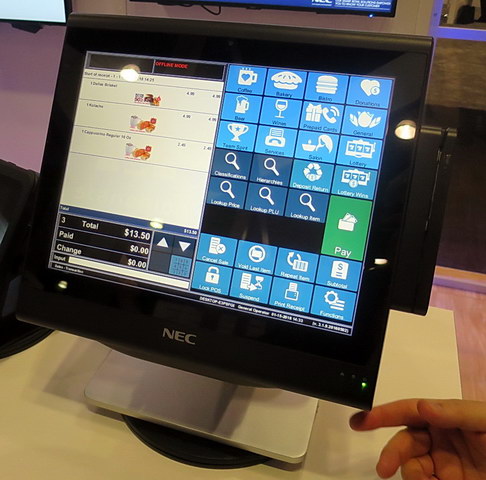 NEC TwinPOS 5100 series terminal at NRF. (Credit: M. Brennesholtz)
NEC TwinPOS 5100 series terminal at NRF. (Credit: M. Brennesholtz)
NEC recently (Dec. 2017) announced three new TWINPOS G5100Li POS models in the TWINPOS G5000 series for North America, Latin America and Southeast Asia. The AIO POS terminals use Intel Core i3 and Core i5 processors in combination with the Windows 10 IoT Enterprise OS.
The main operator display is a 15” LCD with a LED Backlight and a 10-point muti-touch capacitive touchscreen. It has a resolution of 1024 x 768 (XGA) and a brightness of 297 cd/m². There are three choices for the customer display, a 2 x 20 alphanumeric VFD display; a 10.1” LCD with 1280 x 800 resolution and 418 cd/m²; and a 15” LCD with 1024 x 768 resolution and 297 cd/m² brightness. Both customer LCD displays are equipped with capacitive touchscreens. The main operator display terminal has an environmental protection rating of IP64.
According to the NEC rep at NRF, NEC will deliver about 20,000 TwinPOS G5100 models to the 8,600 7-11 stores in the US over the next two years. This will completely re-equip the chain with this POS terminal, replacing all the stores’ previous POS terminals.
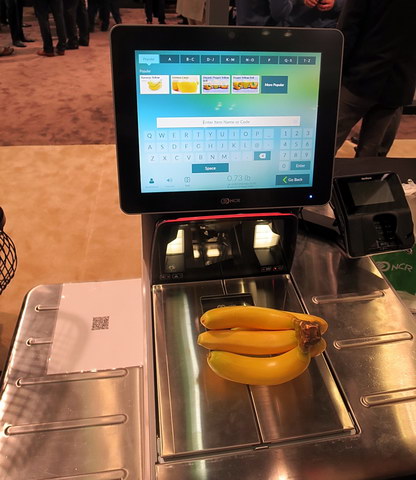 Modern NCR self-checkout system (Credit: M. Brennesholtz)
Modern NCR self-checkout system (Credit: M. Brennesholtz)
At the NRF, NCR celebrated 20 years since the first installation of a NCR self-checkout system. I was disappointed when I visited the booth – I would have liked to have seen one of the old systems. they did, however, have their newest self checkout terminals on display, although they had been introduced last year. The NCR rep told me that the software had been updated for 2018, though.
These units had one interesting feature. A camera with an image recognition system looked at the items without barcode placed on the customer scale. The software then suggested to the customer what the item might be, saving the customer from scrolling through a long menu to find the item. This is said to significantly speed up self-checkout systems. In the example, when a bunch of bananas was placed on the scale, the system offered bananas as first choice but also suggested they might be lemons, organic yellow peppers or regular yellow peppers. That’s neat, and I’d like to see that in stores because I tend to avoid self-checkout when I have items like this precisely because it takes so long to find them on the normal menu system!

